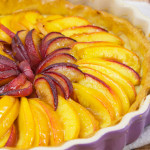
Plum and Nectarine Tart
This Plum and Nectarine Tart may look fancy, but it's SO easy to make! Especially with my fool proof pie crust! A crunchy base and soft, tender fruit that explodes with flavour, makes this tart a must bake this Autumn!
Ingredients
- For the crust:
- 2 cups (280g) plain flour
- 3 tbsp caster sugar
- 1/4 tsp salt
- 1 1/2 sticks (170g) unsalted butter, cold and cut into 1 inch cubes
- 3-4 tbsp ice cold water
- For the filling:
- 2 1/2 large nectarines, halved, de-stoned and sliced thinly
- 3 small plums, halved, de-stoned and sliced thinly
- For the glaze:
- 2 tbsp apricot jam or baking glaze; make sure it's smooth
- 1 tbsp water
Instructions
- Preheat the oven to 200C/400F and spray a 9 inch tart tin with cooking spray. I use Wilton Bake Easy.
- Place the flour, sugar and salt into your food processor. Drop in cubes of cold butter around the whole bowl. Pulse for a few seconds at a time until you have a mixture that resembles coarse breadcrumbs. Add in water, 1tbsp at a time, pulsing in between for at least 20 seconds. (you pulse for longer because you may think you need more water, but in actual fact it will come together if you keep pulsing!). I normally need 4tbsp of water.
- Pulse until your dough comes together and doesn't stick to the sides of the bowl.
- Alternatively you can place flour, sugar, salt and butter into a large bowl and use a pastry blender or your fingers to rub the butter and flour mix together until you have breadcrumb texture. Then add water 1tbsp at a time and mix with your hands until it comes together. I would advise the food processor method.
- Once your dough is ready, lightly flour a silicone pastry mat or your work surface. Tip the dough out and pat into a circle. (At this stage you can wrap the dough in cling film and place in the fridge to chill if required). Lightly flour the top and then roll once with a large rolling pin. Turn the dough 1/8th of a turn to the right and roll once, then turn it another 1/8th of a turn and roll. Continue until pastry is around 1/8th of an inch (3-4mm) thick, just over is fine. Re-flour the dough as required.
- Place rolling pin at one edge and then loosely fold the pastry dough up around the rolling pin. Take it over to your prepared tin and start unrolling it at least 3 inches further forward than your tin (in order to have enough to press it into the tin) Be gentle when un-rolling the dough. Let it fall into the tin. Remove a small piece of dough from one of the edges and roll into a ball.
- Lift and press the dough into the pan using the ball of dough to press it against the side and create a smooth, flat surface. Use your rolling pin to roll over the top of the pie tin gently, to cut away the excess pie dough (see note). (Dough will shrink in the pan, but this is what you want with this recipe as otherwise it will be too tall for the filling). Take a fork and prick holes in the bottom of your crust.
- Place a sheet of grease proof paper in the tin, ensuring it's big enough to come up the sides of the crust too. Tip in baking beans and make sure they cover the bottom of the crust.
- Place in the oven for 10-12 minutes, until the crust is just starting to colour.
- Remove baking beans (I tip them into a bowl to cool) and then place the pie crust back in the oven for 5 minutes.
- After 5 minutes, remove from the oven and leave to cool for 2-3 minutes. Then start with your filling! I started with plums in the centre; Find the centre of your pie and then move outwards slightly. Place slices of plum, overlapping each other in a clockwise circle.
- You can either go the same way or opposite way with the slices of nectarine, but follow the same process, overlap each slice and turn slightly so the slices will go all around the pie and meet each other.
- Place in the oven for 17-20 minutes until the fruit looks soft and ever so slightly browned. Crust will be golden. I always use a pie crust shield around the edges of my pies to make sure the edges don't get too brown. If you don't have one, roll up some foil and then shape it around the tin to cover the edges.
- Leave pie to cool completely before adding glaze. Place apricot glaze into a small bowl and ad in water. Mix until well combined and smooth. you want a fairly runny mixture. Brush the mixture all over the fruit and crust to create that glossy finish.
- DEVOUR! Tart will keep covered, in the fridge, for 3 days.
Notes
*I would normally blind bake the crust and then roll over the top to trim the excess pie dough, in order to avoid shrinkage. However, in this tart, I wanted the sides to get a little shorter, so they were the perfect height for the filling, hence why I removed the excess before baking. Recipe by Annie of Annie's Noms